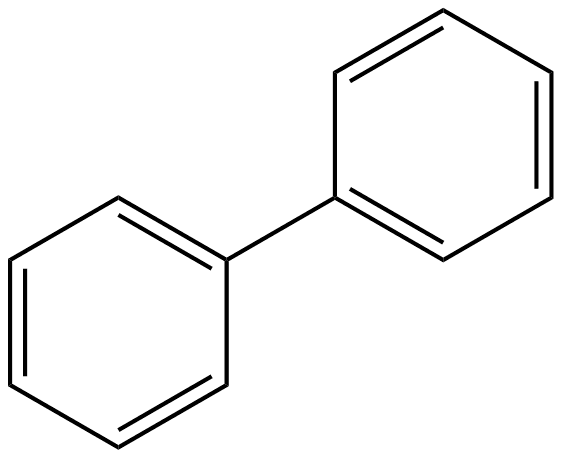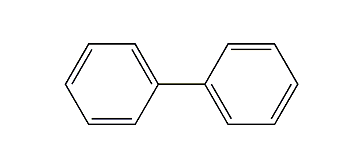Formula C12H10 Molar mass 154.21 g/mol Boiling point 255 °C | Melting point 69.2 °C IUPAC ID Biphenyl Density 1.04 g/cm³ | |
 | ||
Appearance Colorless to pale-yellow crystals | ||
Biphenyl system in chemistry quick overview by r k shubhanker iit chennai
Biphenyl (or diphenyl or phenylbenzene or 1,1′-biphenyl or lemonene) is an organic compound that forms colorless crystals. Particularly in older literature, compounds containing the functional group consisting of biphenyl less one hydrogen (the site at which it is attached) may use the prefixes xenyl or diphenylyl.
Contents
- Biphenyl system in chemistry quick overview by r k shubhanker iit chennai
- Properties and occurrence
- Natural occurrence
- Reactions and uses
- Stereochemistry
- Biological aspects
- Biphenyl compounds
- References

It has a distinctively pleasant smell. Biphenyl is an aromatic hydrocarbon with a molecular formula (C6H5)2. It is notable as a starting material for the production of polychlorinated biphenyls (PCBs), which were once widely used as dielectric fluids and heat transfer agents.

Biphenyl is also an intermediate for the production of a host of other organic compounds such as emulsifiers, optical brighteners, crop protection products, and plastics. Biphenyl is insoluble in water, but soluble in typical organic solvents. The biphenyl molecule consists of two connected phenyl rings.

Properties and occurrence
Biphenyl is produced industrially as a byproduct of the dealkylation of toluene to produce benzene:
C6H5CH3 + C6H6 → C6H5−C6H5 + CH4The other principal route is by the oxidative dehydrogenation of benzene:
2 C6H6 + 1⁄2 O2 → C6H5−C6H5 + H2O40,000,000 kg are produced annually by these routes.
In the laboratory, biphenyl can also be synthesized by treating phenylmagnesium bromide with copper salts.
Natural occurrence

Biphenyl occurs naturally in coal tar, crude oil, and natural gas and can be isolated from these sources via distillation.
Reactions and uses

Lacking functional groups, biphenyl is fairly non-reactive, which is the basis of its main application. Biphenyl is mainly used as a heat transfer agent as a eutectic mixture with diphenylether. This mixture is stable to 400 °C.

Biphenyl does undergo sulfonation followed by base hydrolysis produces p-hydroxybiphenyl and p,p′-dihydroxybiphenyl, which are useful fungicides. In another substitution reactions, it undergoes halogenation. Polychlorinated biphenyls were once popular pesticides.
Stereochemistry
Rotation about the single bond in biphenyl, and especially its ortho-substituted derivatives, is sterically hindered. For this reason, some substituted biphenyls show atropisomerism; that is, the individual C2-symmetric-isomers are optically stable. Some derivatives, as well as related molecules such as BINAP, find application as ligands in asymmetric synthesis. In the case of unsubstituted biphenyl, the equilibrium torsional angle is 44.4° and the torsional barriers are quite small, 6.0 kJ/mol at 0° and 6.5 kJ/mol at 90°. Adding ortho substituents greatly increases the barrier: in the case of the 2,2'-dimethyl derivative, the barrier is 17.4 kcal/mol (72.8 kJ/mol).
Biological aspects
Biphenyl prevents the growth of molds and fungus, and is therefore used as a preservative (E230, in combination with E231, E232 and E233), particularly in the preservation of citrus fruits during transportation. It is no longer approved as a food additive in the European Union.
It is mildly toxic, but can be degraded biologically by conversion into nontoxic compounds. Some bacteria are able to hydroxylate biphenyl and its polychlorinated biphenyls (PCBs).
It is part of the active group in the antibiotic oritavancin.
Biphenyl compounds
Substituted biphenyls and have many uses. They are prepared by various coupling reactions including the Suzuki-Miyaura reaction and the Ullmann reaction. Polychlorinated biphenyls were once used as cooling and insulating fluids and polybrominated biphenyls are flame retardants. The biphenyl motif also appears in drugs such as diflunisal and telmisartan. The abbreviation E7 stands for a liquid crystal mixture consisting of several cyanobiphenyls with long aliphatic tails used commercially in liquid crystal displays. A variety of benzidine derivatives are used in dyes and polymers. Research into biphenyl liquid crystal candidates mainly focuses on molecules with highly polar heads (for example cyano or halide groups) and aliphatic tails.
